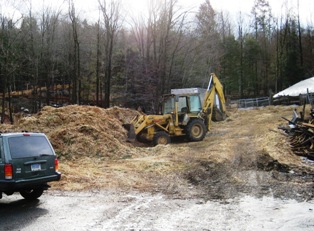|
Straight forward pig facts allow you to comfortably chose pork from Eagle Wood Farms.
Through trial and error we have determined that a hog cross breed of Duroc and Yorkshire is best suited to our local environment of extreme sub zero winters and long hot humid summers.  Yorkshires, many consider them the mother of all pigs. It is speculated that pigs were first domesticated almost 7,000 years ago in China and the near east. In the 11th century wild boar became domesticated in England. Unsubstantiated facts show that in the 18th century Chinese pigs were brought to England and the gene pool mixed yielding the Yorkshire or large white breed. It is believed the Yorkshire came to Ohio around 1830.
Yorkshires, many consider them the mother of all pigs. It is speculated that pigs were first domesticated almost 7,000 years ago in China and the near east. In the 11th century wild boar became domesticated in England. Unsubstantiated facts show that in the 18th century Chinese pigs were brought to England and the gene pool mixed yielding the Yorkshire or large white breed. It is believed the Yorkshire came to Ohio around 1830. This breed has set the standard for large litter sizes, good milking ability, strong mothering instincts at birth and through weaning. They consistently have high yielding carcasses. They have a long, big frame and are white with erect ears. Duroc pigs are reddish in color with droopy ears. Duroc is considered, by many, to have the best tasting pork. It is also considered one of the hardiest breeds and they do well outside with simple housing. This is the red pig. Facts show it came from Spain or Portugal in the mid 1800’s. These hogs, noted for their fast growth and good feed efficiency, are a reddish color with droopy ears. On the average, this breed needs less feed to make a pound of muscle than the other breeds. Pig Facts 2 - Husbandry /Feed Our pigs are stress free because they can roam around alone or in groups, build nests, and chew on things, many things. Unable to sweat, pigs regulate their body temperatures by lying in the mud. Stress free hogs have no diseases, grow faster and have better tasting meat. At night and in bad weather pigs spend time inside open ended structures. Our bedding is three foot thick of wood chips instead of dirt or concrete. We replace the top 12 inches weekly and place it on a compost pile where it is used and sold as compost one year later helping our community reduce its need for chemical fertilizers. This thick bedding acts a cushion on pig joints reducing lameness. As urine and feces mixes with the chips, constant fermentation destroys pathogens and parasites. Heat from fermentation moderates the indoor temperature during our extreme winters. Indoor air gases or air born pathogens are not a problem with the constant removal of waste and the ventilation through our open ended buildings. We record detailed pig facts and document that we have minimal veterinary bills but consequently this system is very labor and equipment intensive.  Pigs have a single stomach, similar to humans. To maintain robust health and grow efficiently, pigs need grain that is low in fiber (cellulose) and is supplemented with adequate protein. We purchase our natural pig food from the local farm co-op where the grain is mostly wheat blended with a mixture of barley, oats, corn and a multivitamin supplement. As omnivores, pigs also graze and root (turn up soil) everywhere on the property, eating small plants, our own vegetables, insects and very small animals. They also graze on large bails of hay which we leave around the property for cattle, sheep and goats.
Pigs have a single stomach, similar to humans. To maintain robust health and grow efficiently, pigs need grain that is low in fiber (cellulose) and is supplemented with adequate protein. We purchase our natural pig food from the local farm co-op where the grain is mostly wheat blended with a mixture of barley, oats, corn and a multivitamin supplement. As omnivores, pigs also graze and root (turn up soil) everywhere on the property, eating small plants, our own vegetables, insects and very small animals. They also graze on large bails of hay which we leave around the property for cattle, sheep and goats.On our farm sows are bred only twice a year, and they farrow in larger pens that protect the piglets from extreme weather conditions but still allow freedom of movement. We do not use antibiotics to promote growth, or to control or mask disease as with sub-therapeutic doses of antibiotics in feed. We believe in ethical, appropriate veterinary care. Through the age of 6 weeks an animal may receive reasonable therapeutic treatment for a specific illness. It must be prescribed by an independent veterinarian. After six weeks in age, we determine if an animal stays within our natural sustainable guidelines. If the animal receives treatment it will be removed from the herd. Within the six weeks we will keep the animal to slaughter at maturity in 4 to 5 months. When a meat animal from any farm receives treatment before slaughter we should all be concerned about drug withdrawal time. The withdrawal period is the amount of time a drug needs to be eliminated from an animal’s body through sweat, urine and feces. On the rare occasions when veterinary care is needed here, a typical dose of antibiotic for 48 hours has a 5 day withdrawal period. This animal would not be slaughtered for over four months. Pig Facts 3 - Processing / Slaughtering Slaughtering is the grim part of the pork business. Everyone at Eagle Wood Farms is humbled that pigs give their lives for our nutrition. We treat our animals with dignity and respect. Animals are killed quickly in segregated rooms. Numbers are kept to a minimum to reduce stress, reduce danger to employees and to maintain the high quality of both our retail and mail order meats. Animal Stress and Meat - The energy required for muscle activity in the live animal is obtained from sugars (glycogen) in the muscle of the pig. Facts show that in a healthy and well-rested animal, the glycogen content of the muscle is high. Pig facts show that after the animal has been slaughtered, the glycogen in the muscle is converted into lactic acid, and the muscle and carcass becomes firm (rigor mortis). This lactic acid is necessary to produce meat, which is tasteful and tender, of good keeping quality and good bright pink color. If the animal is stressed before and during slaughter, the glycogen is used up, and the lactic acid level that develops in the meat after slaughter is reduced producing dark meat within the pig. Facts reveal that lactic acid in the muscle has the effect of retarding the growth of bacteria that have contaminated the carcass during slaughter and dressing. Pig carcasses do not need hanging or aging as with beef. Experienced butchers, at a family owned USDA approved slaughter house, create the retail cuts based upon our customers’ requests and the inherent muscle structure of the animal. All cuts are vacuumed packed, fresh frozen and delivered to our store in Barkhamsted, Connecticut. We provide you the reader with simple, no nonsense pig facts as they relate to our farm. We hope this information has been useful and allows your enough comfort to order food for yourself and family. Please do not hesitate to contact us. Return from Pig Facts to Pork Main Page Contact Eagle Wood Farms Eagle Wood Home Page |



